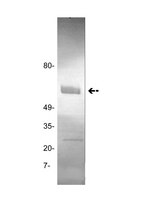05-883 Sigma-AldrichAnti-tPA (Tissue Plasminogen Activator) Antibody, clone GMA-043
Detect tPA (Tissue Plasminogen Activator) using this Anti-tPA (Tissue Plasminogen Activator) Antibody, clone GMA-043 validated for use in ELISA & WB.
More>> Detect tPA (Tissue Plasminogen Activator) using this Anti-tPA (Tissue Plasminogen Activator) Antibody, clone GMA-043 validated for use in ELISA & WB. Less<<Produits recommandés
Aperçu
| Replacement Information |
|---|
Tableau de caractéristiques principal
| Species Reactivity | Key Applications | Host | Format | Antibody Type |
|---|---|---|---|---|
| H | ELISA, WB | M | Purified | Monoclonal Antibody |
| Description | |
|---|---|
| Catalogue Number | 05-883 |
| Brand Family | Upstate |
| Trade Name |
|
| Description | Anti-tPA (Tissue Plasminogen Activator) Antibody, clone GMA-043 |
| References |
|---|
| Product Information | |
|---|---|
| Format | Purified |
| Presentation | 100 µg of protein G purified mouse IgG1 lyophilized from 10 mM NaH2PO4, 0.15 M NaCl, 1.0% mannitol, pH 7.4. |
| Quality Level | MQ100 |
| Physicochemical Information |
|---|
| Dimensions |
|---|
| Materials Information |
|---|
| Toxicological Information |
|---|
| Safety Information according to GHS |
|---|
| Safety Information |
|---|
| Storage and Shipping Information | |
|---|---|
| Storage Conditions | stable 2 years at -20°C from date of shipment |
| Packaging Information | |
|---|---|
| Material Size | 100 µg |
| Transport Information |
|---|
| Supplemental Information |
|---|
| Specifications |
|---|
| Global Trade Item Number | |
|---|---|
| Référence | GTIN |
| 05-883 | 04053252670435 |
Documentation
Anti-tPA (Tissue Plasminogen Activator) Antibody, clone GMA-043 FDS
| Titre |
|---|
Anti-tPA (Tissue Plasminogen Activator) Antibody, clone GMA-043 Certificats d'analyse
Références bibliographiques
| Aperçu de la référence bibliographique | Nº PubMed |
|---|---|
| Tissue plasminogen activator as a modulator of neuronal survival and function Tsirka, Stella E Biochem Soc Trans, 30:222-5 (2002) 2002 | 12023855
 |
| Update on intravenous tissue plasminogen activator for acute stroke: from clinical trials to clinical practice Gladstone, D J and Black, S E CMAJ : Canadian Medical Association journal = journal de l'Association medicale canadienne, 165:311-7 (2001) 2001 | 11517650
 |
| Tissue-type plasminogen activator: characteristics, applications and production technology. Rouf, S A, et al. Biotechnol. Adv., 14: 239-66 (1996) 1996 Afficher le résumé | 14537155
 |







